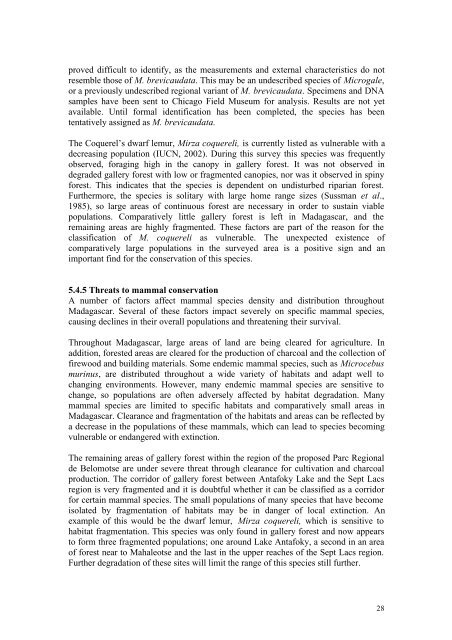The proposed Parc Regional de Belomotse - Frontier-publications ...
The proposed Parc Regional de Belomotse - Frontier-publications ...
The proposed Parc Regional de Belomotse - Frontier-publications ...
Create successful ePaper yourself
Turn your PDF publications into a flip-book with our unique Google optimized e-Paper software.
proved difficult to i<strong>de</strong>ntify, as the measurements and external characteristics do not<br />
resemble those of M. brevicaudata. This may be an un<strong>de</strong>scribed species of Microgale,<br />
or a previously un<strong>de</strong>scribed regional variant of M. brevicaudata. Specimens and DNA<br />
samples have been sent to Chicago Field Museum for analysis. Results are not yet<br />
available. Until formal i<strong>de</strong>ntification has been completed, the species has been<br />
tentatively assigned as M. brevicaudata.<br />
<strong>The</strong> Coquerel’s dwarf lemur, Mirza coquereli, is currently listed as vulnerable with a<br />
<strong>de</strong>creasing population (IUCN, 2002). During this survey this species was frequently<br />
observed, foraging high in the canopy in gallery forest. It was not observed in<br />
<strong>de</strong>gra<strong>de</strong>d gallery forest with low or fragmented canopies, nor was it observed in spiny<br />
forest. This indicates that the species is <strong>de</strong>pen<strong>de</strong>nt on undisturbed riparian forest.<br />
Furthermore, the species is solitary with large home range sizes (Sussman et al.,<br />
1985), so large areas of continuous forest are necessary in or<strong>de</strong>r to sustain viable<br />
populations. Comparatively little gallery forest is left in Madagascar, and the<br />
remaining areas are highly fragmented. <strong>The</strong>se factors are part of the reason for the<br />
classification of M. coquereli as vulnerable. <strong>The</strong> unexpected existence of<br />
comparatively large populations in the surveyed area is a positive sign and an<br />
important find for the conservation of this species.<br />
5.4.5 Threats to mammal conservation<br />
A number of factors affect mammal species <strong>de</strong>nsity and distribution throughout<br />
Madagascar. Several of these factors impact severely on specific mammal species,<br />
causing <strong>de</strong>clines in their overall populations and threatening their survival.<br />
Throughout Madagascar, large areas of land are being cleared for agriculture. In<br />
addition, forested areas are cleared for the production of charcoal and the collection of<br />
firewood and building materials. Some en<strong>de</strong>mic mammal species, such as Microcebus<br />
murinus, are distributed throughout a wi<strong>de</strong> variety of habitats and adapt well to<br />
changing environments. However, many en<strong>de</strong>mic mammal species are sensitive to<br />
change, so populations are often adversely affected by habitat <strong>de</strong>gradation. Many<br />
mammal species are limited to specific habitats and comparatively small areas in<br />
Madagascar. Clearance and fragmentation of the habitats and areas can be reflected by<br />
a <strong>de</strong>crease in the populations of these mammals, which can lead to species becoming<br />
vulnerable or endangered with extinction.<br />
<strong>The</strong> remaining areas of gallery forest within the region of the <strong>proposed</strong> <strong>Parc</strong> <strong>Regional</strong><br />
<strong>de</strong> <strong>Belomotse</strong> are un<strong>de</strong>r severe threat through clearance for cultivation and charcoal<br />
production. <strong>The</strong> corridor of gallery forest between Antafoky Lake and the Sept Lacs<br />
region is very fragmented and it is doubtful whether it can be classified as a corridor<br />
for certain mammal species. <strong>The</strong> small populations of many species that have become<br />
isolated by fragmentation of habitats may be in danger of local extinction. An<br />
example of this would be the dwarf lemur, Mirza coquereli, which is sensitive to<br />
habitat fragmentation. This species was only found in gallery forest and now appears<br />
to form three fragmented populations; one around Lake Antafoky, a second in an area<br />
of forest near to Mahaleotse and the last in the upper reaches of the Sept Lacs region.<br />
Further <strong>de</strong>gradation of these sites will limit the range of this species still further.<br />
28
















